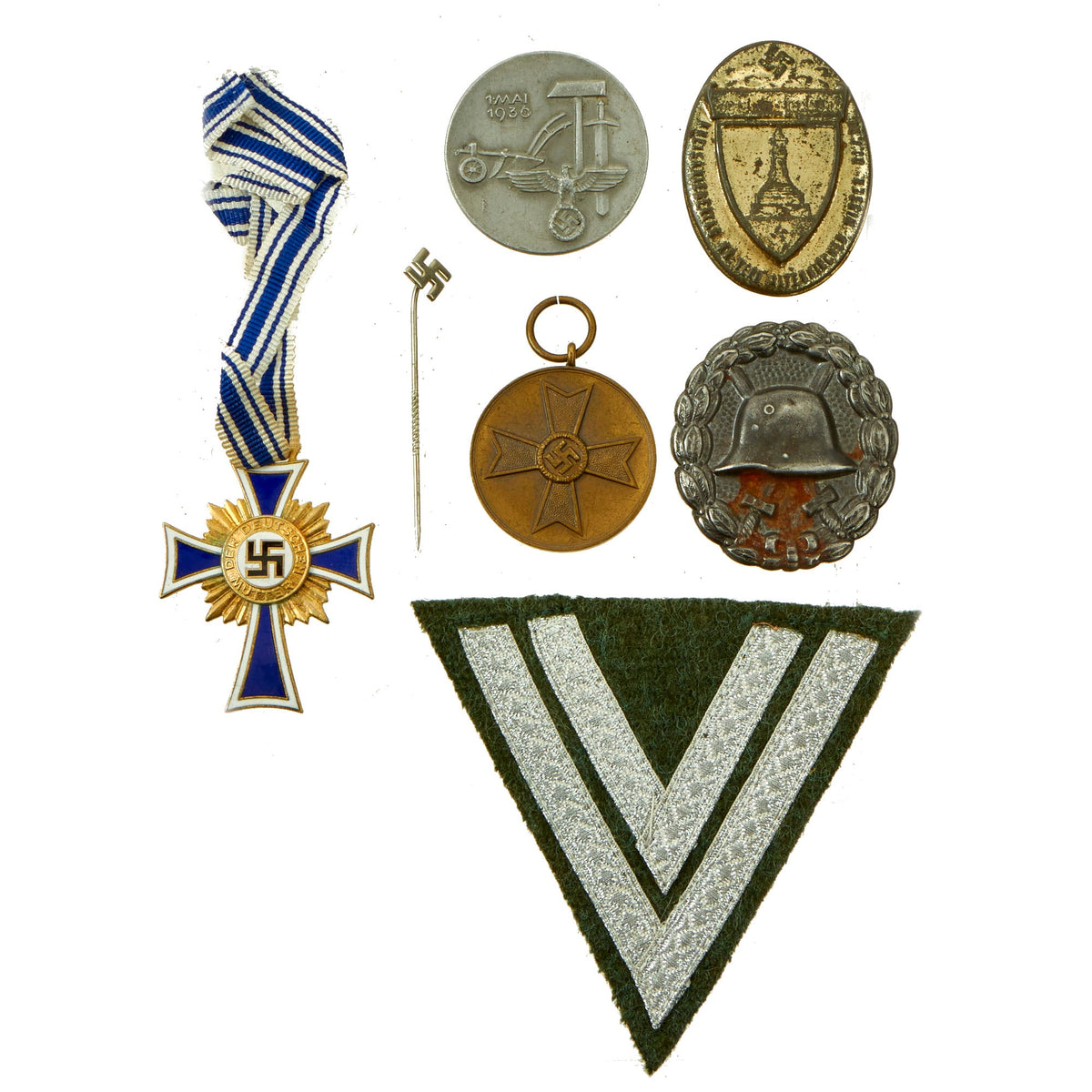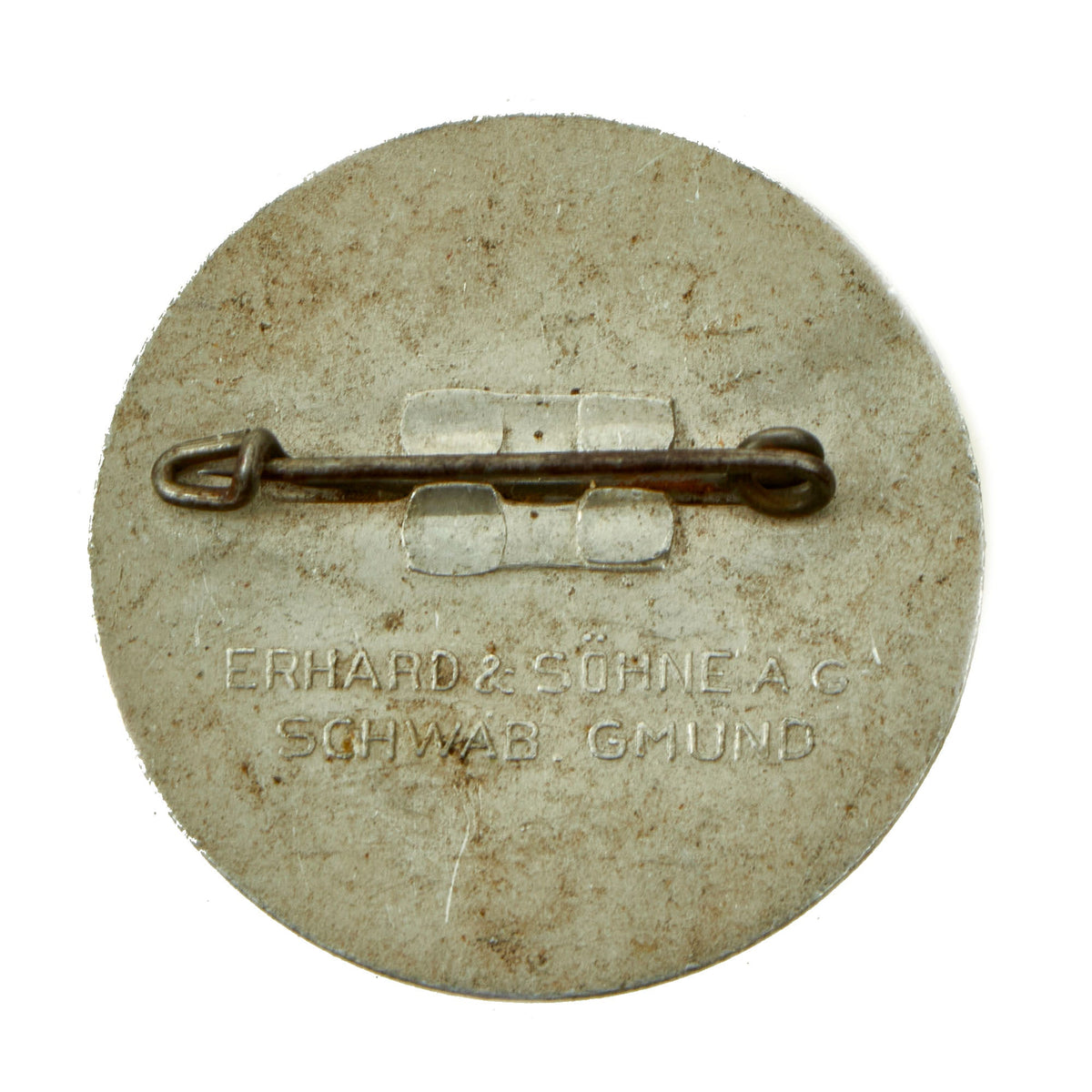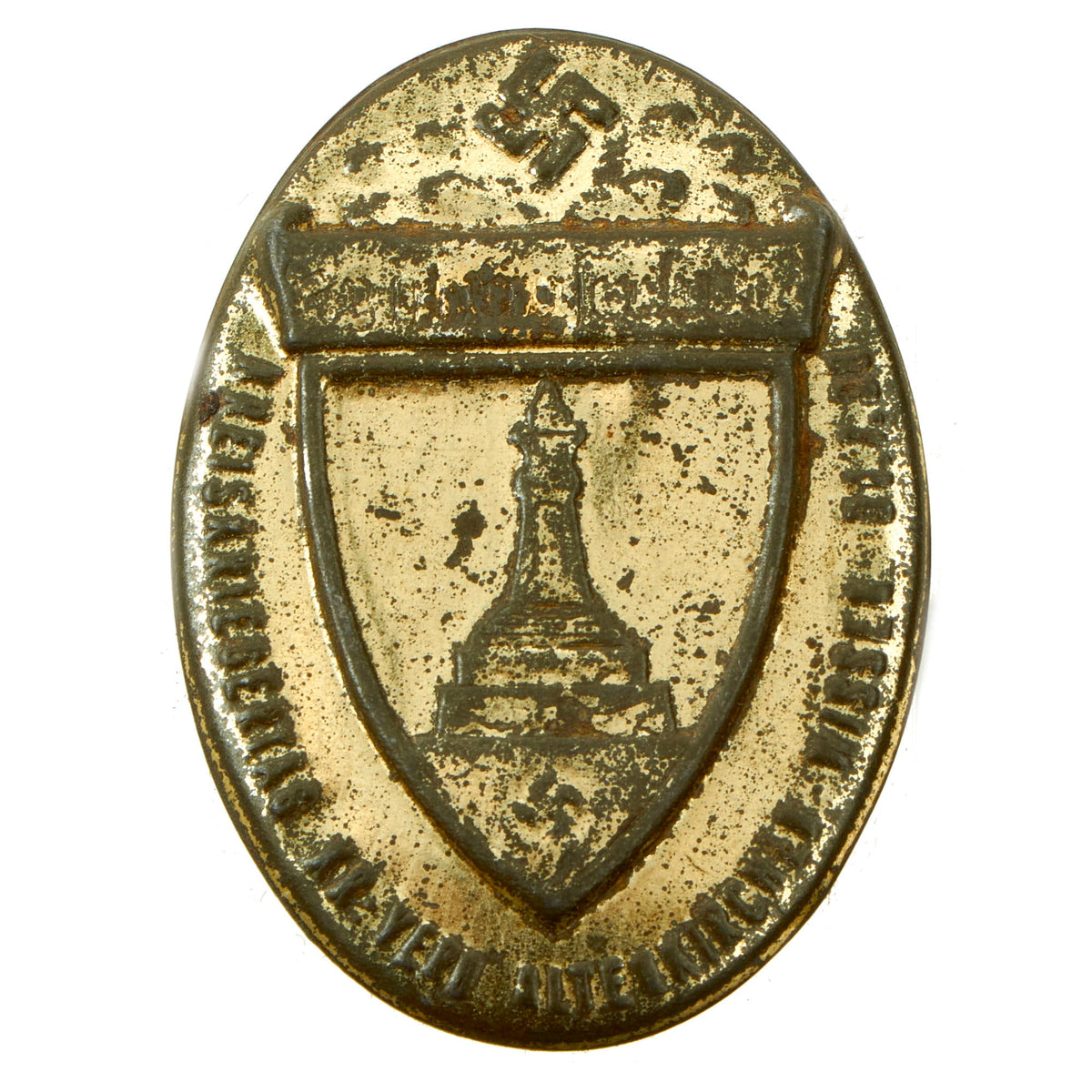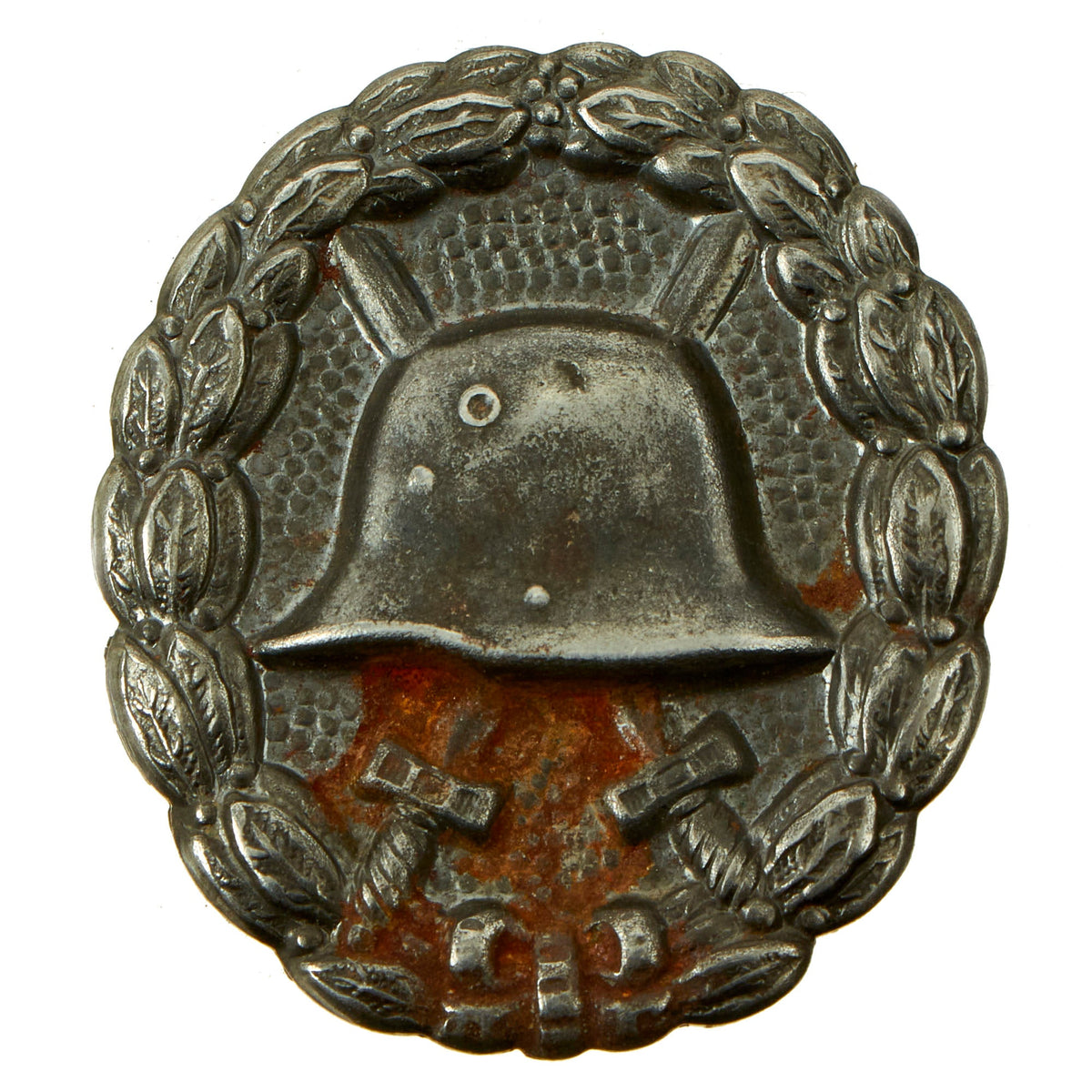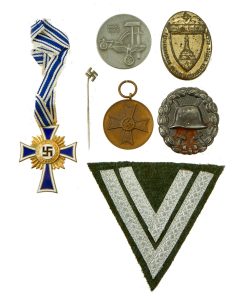Original German WWI & WWII Medal and Insignia Grouping with WWI Wound Badge & Mother’s Cross – 7 Items Original Items
$ 295,00 $ 118,00
Original Items: Only One Set Available. This is a very nice collection of German WWI & WWII Insignia & Awards, which was brought back from the European theater by a USGI after the war was concluded. It includes some a wide variety of medals and insignia, including a WWI Wound Badge, Gold Mother’s Cross, an even some tinnies!
This lovely set includes:
– One Imperial German WWI Wound Badge 3rd Class in Black. Stamped steel construction with the pinback unfortunately missing.
– German WWII 1939 War Merit Medal (Kriegsverdienstmedaille), without ribbon.
– One German WWII Mothers Cross 1st Class in Gold, for eligible mothers with 8 or more children. Much of the gold color is very well retained, and the enamel is great. It still has a short section of ribbon installed.
– One German Pre-WWII 1 MAI 1936 (May Day, labor day) Tinnie with pinback. Aluminum construction with only light oxidation, and maker marked on the reverse.
– One German WWII Wehrmacht Army Heer Mannschaften (Enlisted Men) Double Silver Chevron badge on Field Gray Backing, indicating the rank of Obergefreiter, equivalent to a U.S. Army Corporal.
– One German WWII NS-RKB Veteran’s Association Event Tinnie for “KREISKRIEGERTAG” 31.7.38. Made from plated stamped steel, with a functional pinback.
– One Small NSDAP Party Swas Stick Pin
A wonderful totally genuine grouping perfect for the German Medal and Insignia collector.
The German Wound Badge (Verwundetenabzeichen) was instituted during the First World War to recognize those wounded in the conflict. It was designed using a World War One style Imperial German helmet as the main motif. The helmet was set on top two crossed swords against a pebbled background and surrounded by a laurel leaves wreath.
The Wound Badge Awards came in three different types of grades representing the amount , or severity, of wounds received. The first grade, the Black Wound Badge was awarded for 1 to 2 wounds received in combat. The Silver Grade was awarded for 3 to 4 wounds, and finally the Gold Grade for 5 or more wounds, total disability, or death.
The War Merit Medal (Kriegsverdienstmedaille) was a World War II German military decoration awarded to recognize outstanding service by civilians in relation to the war effort. It was instituted on 19 August 1940 and usually awarded to those workers in factories who significantly exceeded work quotas. The War Merit Medal was awarded only to Germans and non-Germans civilians, to men and women. An estimated 4.9 million medals were awarded by the end of the war in Europe. It was closely related to the War Merit Cross, which could be awarded to military personnel and civilians alike for outstanding service to the war effort.
The medal was designed by Professor Richard Klein of Munich. It was a circular bronze award bearing the design of the War Merit Cross on the front (obverse), and the inscription “For War Merit 1939” (Für Kriegsverdienst 1939) on the reverse side. It was suspended from a ribbon colored similar to the War Merit Cross, except for a thin red vertical strip added to the center of the black portion. When worn, it was either as a medal ribbon bar above the left breast pocket (soldiers who had earned the medal as civilians could wear it on their uniform), or with the ribbon only through the second buttonhole of a jacket. Since this was a non-combat award, the medal never incorporated swords. After 15 May, 1943, the award of this medal to foreigners was superseded by the Medal of Merit of the Order of the German Eagle.
The Cross of Honour of the German Mother, referred to colloquially as the Mutterehrenkreuz (Mother’s Cross of Honor) or simply Mutterkreuz (Mother’s Cross), was a state decoration conferred by the government of the German Reich to honor a Reichsdeutsche German mother for exceptional merit to the German nation. Eligibility later extended to include Volksdeutsche (ethnic German) mothers from, for example, Austria and Sudetenland, that had earlier been incorporated into the German Reich.
The decoration was conferred from 1939 until 1945 in three classes: bronze, silver, and gold, to Reichsdeutsche mothers who exhibited probity, exemplary motherhood, and who conceived and raised at least four or more children in the role of a parent. A similar practice, that continues to this present day, was already established in France since 1920, by conferring the Médaille de la Famille française (Medal of the French Family), a tribute to the French mother who raised several children in an appropriate way.
In recognition of the substantial importance a woman’s role and motherhood was in support of a strong Germany, the Cross of Honor of the German Mother was introduced by decree in Berlin on 16 December 1938 by Führer und Reichskanzler (leader and chancellor) AH. The preamble of the statutory decree declared:
As a visible sign of gratitude of the German nation to children-rich mothers I establish this Cross of Honor of the German Mother
The crosses were awarded annually on the second Sunday in May (Mothering Sunday or Mother’s Day), but also extended to include other national annual occasions of celebration. So despite its institution in 1938, the first awards were rendered in May 1939.
The Mother’s Cross was composed of three classes, and conferred to mothers in accordance with its statutory legislation: Verordnung des Führers und Reichskanzlers über die Stiftung des Ehrenkreuzes der Deutschen Mutter vom 16. Dezember 1938. Reichsgesetzblatt (RGBI) Teil I, 1938, Nr. 224, Seite 1923 (In English: Statutory Order of the Leader and Chancellor on the establishment of the Cross of Honor of the German Mother of 16 December 1938. Imperial-(Reichs) Law Gazette (RGBl) Part I, 1938, No. 224, Page 1923), and its stringent nomination screening protocol.
Classes
-1st class, Gold Cross: eligible mothers with eight or more children
-2nd class, Silver Cross: eligible mothers with six or seven children
-3rd class, Bronze Cross: eligible mothers with four or five children
The cross design is a slender elongated form of the Iron Cross or cross pattée and very similar in design to the Marian Cross of the Teutonic Order, enameled translucent-blue with a slim opaque-white border. Resting on the center radiant starburst rays is a metal roundel decorated with the words DER DEUTSCHEN MUTTER (in English: TO THE GERMAN MOTHER) around an enameled black straight centered “swas” symbol, infilled white enamel. Reverse of medal reads 16 December 1938, which is the date that the award was first established, along with AH’s Signature.
The cross design was the creation of the established Munich-based architect and sculptor Franz Berberich. The production of the cross involved several established Präsidialkanzlei (Presidential Chancellery) approved medal makers from across the German Reich. A maker’s mark was never applied to the crosses produced; though each official house of manufacture did apply their name to the dark-blue presentation case (inside cover) for the 1st Class Gold Cross and the presentation sachets (reverse side) for each of the 2nd and 3rd Class Cross.
Fast Shipping with Professional Packaging
Thanks to our longstanding association with UPS FedEx DHL, and other major international carriers, we are able to provide a range of shipping options. Our warehouse staff is expertly trained and will wrap your products according to our exact and precise specifications. Prior to shipping, your goods will be thoroughly examined and securely secured. We ship to thousands clients each day across multiple countries. This shows how we're dedicated to be the largest retailer on the internet. Warehouses and distribution centres can be located throughout Europe as well as the USA.
Note: Orders with more than one item will be assigned a processing date depending on the item.
Before shipping before shipping, we'll conduct a thorough inspection of the items you have ordered. Today, the majority of orders will be delivered within 48 hours. The delivery time will be between 3-7 days.
Returns
The stock is dynamic and we cannot completely manage it because multiple stakeholders are involved, including our factory and warehouse. So the actual stock may alter at any time. It's possible that you may not receive your order once the order has been made.
Our policy is valid for a period of 30 days. If you don't receive the product within 30 days, we are not able to issue a refund or an exchange.
You can only return an item if it is unused and in the same state as the day you received it. You must have the item in its original packaging.
Related products
Uncategorized
Uncategorized
Uncategorized
Uncategorized
Uncategorized
Australian WWII Owen MK1 Machine Carbine SMG Custom Fabricated Replica with Sling Original Items
Uncategorized
Uncategorized
Uncategorized
Uncategorized
Uncategorized
Uncategorized
Uncategorized
Uncategorized
Uncategorized
Uncategorized
Uncategorized
Uncategorized
Uncategorized
